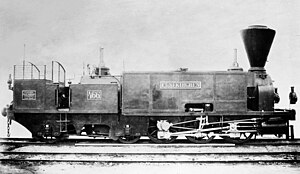StEG I 466-475
| StEG I 466–475 / StEG II 728–737 / StEG 3251–3255 | |
|---|---|
|
Footbridge I 466 FIVE CHURCHES
|
|
| Numbering: | StEG I 466–475 StEG II 728–737 StEG 3251–3255 |
| Number: | 10 |
| Manufacturer: | StEG locomotive factory |
| Year of construction (s): | 1856 |
| Retirement: | before 1909 |
| Type : | C2 'n2st |
| Gauge : | 1435 mm ( standard gauge ) |
| Length over buffers: | 11,356 mm |
| Height: | 4.662 mm |
| Width: | 2.897 mm |
| Fixed wheelbase: | 2,686 mm |
| Total wheelbase: | 6,726 mm |
| Empty mass: | 42.0 t |
| Service mass: | 55.0 t |
| Driving wheel diameter: | 1,264 mm |
| Impeller diameter: | 948 mm |
| Number of cylinders: | 2 |
| Cylinder diameter: | 434 mm |
| Piston stroke: | 632 mm |
| Boiler overpressure: | 8.0 atm |
| Number of heating pipes: | 181 |
| Heating pipe length: | 4,741 mm |
| Grate area: | 1.35 m² |
| Radiant heating surface: | 7.8 m² |
| Tubular heating surface: | 140.2 m² |
| Evaporation heating surface: | 148.0 m² |
| Water supply: | 6.9 m³ |
| Fuel supply: | 3.4 m³ (coal) |
The StEG I 466-475 were Engerth locomotives of the Staats-Eisenbahn-Gesellschaft (StEG), a private Austrian-Hungarian railway company .
The ten machines belonged to a larger number of StEG Engerth locomotives that were procured from different manufacturers and therefore differed more or less from one another. The vehicles discussed here were supplied by the StEG locomotive factory in 1856. They got the numbers 466-475 in the first designation scheme of the StEG as well as the names TRENTSCHIN , GÜNS , TITEL , BECSKEREK , NAGY-BÁNYA , KLAUSENBURG , KRONSTADT , TANCSOVA , FÜNFKIRCHEN and GROSSWARDEIN .
In the designation scheme of 1873, the machines were assigned the numbers 728–737 and the category IVh. In 1897 the remaining five locomotives came as 3251-3255 in the third designation scheme of the StEG. When the StEG was nationalized in 1909, they were no longer in the locomotive inventory.
literature
- Overview of the locomotive park (and tender of the kk priv. Staats-Eisenbahn-Gesellschaft in Vienna) . Vienna 1879.
